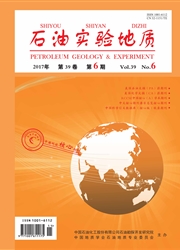

 中文摘要:
中文摘要:
通过对塔里木盆地轮南地区奥陶系风化壳缝洞充填物的观察与分析,识别出3类不同的充填物:流水机械充填物、化学淀积物及重力垮塌堆积物。对其与基岩化学组分、微量元素对比研究,表明不同充填物形成时流体性质和古水文环境不同.其元素的迁移、富集和分馏效应也不同。因此可以利用充填物化学组分和微量元素的迁移、富集特征,来判别轮南地区古风化壳缝洞充填过程中流体性质和古水文环境。经分析,发现3类充填环境:渗流一活跃潜流带的氧化性活跃淡水环境、静滞潜流淡水环境及浅埋藏压释水热水环境,为古岩溶储层预测和评价提供依据。
 英文摘要:
英文摘要:
In the Ordovician karstic fractures and caves in Lunnan area of the Tarim Basin, three types of depo- sits have been identified including water mechanical fillings , chemical deposits and gravity collapse debris. The comparisons of chemical and trace element compositions between deposits and bedrocks have indicated that when different deposits were formed, fluid properties and hydrological environment were different, and the migration, enrichment and fractionation of elements were also different. As a result, the chemical and trace element compo- sitions can be used to judge the fluid properties and hydrological environment when the Ordovician karstic frac- tures and caves were filled. Three kinds of filling environment have been found including oxidizing active freshwater environment in seepage-active undercurrent zone, freshwater environment in stagnant undercurrent zone as well as pressure-released and hot water environment in shallow-buried zone. The study is helpful for karstic reservoir prediction and evaluation.
 同期刊论文项目
同期刊论文项目
 同项目期刊论文
同项目期刊论文
 期刊信息
期刊信息
